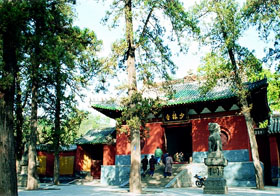 Known worldwide as the cradle of Chinese martial arts, Shaolin Monastery is 80 kilometers southeast of Luoyang at the western edge of Songshan, the central of China's four sacred Taoist peaks. It can be reached in 3 hours on a country road through farming villages. The fame has brought change and it is far from a remote and romantic retreat where the wisdom of the ages is passed from master to novice. It is now a major tourist area, as well as a place of pilgrimage for monks and lay Buddhists. A training hall has been built next to the monastery for the many foreign enthusiasts that come to study. The founder of the monastery was the Indian monk Bodhidharma, where he reportedly sat facing the back wall of a cave and meditated for nine years. His silhouette is said to have been imprinted on the rock. Imperial sanctions ensured the growth of Shaolin's reputation as a martial arts center.
Known worldwide as the cradle of Chinese martial arts, Shaolin Monastery is 80 kilometers southeast of Luoyang at the western edge of Songshan, the central of China's four sacred Taoist peaks. It can be reached in 3 hours on a country road through farming villages. The fame has brought change and it is far from a remote and romantic retreat where the wisdom of the ages is passed from master to novice. It is now a major tourist area, as well as a place of pilgrimage for monks and lay Buddhists. A training hall has been built next to the monastery for the many foreign enthusiasts that come to study. The founder of the monastery was the Indian monk Bodhidharma, where he reportedly sat facing the back wall of a cave and meditated for nine years. His silhouette is said to have been imprinted on the rock. Imperial sanctions ensured the growth of Shaolin's reputation as a martial arts center.
It still houses 70 monks to this day. One of its greatest treasures are the 18 art frescoes, painted in 1828, depicting ancient monks in classic fighting poses that today's novices attempt to emulate. In Thousand Buddha Hall, depressions in the stone floor of this main hall of the temple serve as reminders of the tough combat exercises performed by the monks. Southwest of the monastery is Stupa Forest and its 230 monuments and burial mounds, the oldest of which dates from the Tang Dynasty.
The Shaolin Monastery, in the Songshan Range near Luoyang, is the home of most Asian martial arts. Be it Kung fu or karate, taekwondo or judo, they all originated in ancient China as fighting techniques of one individual against another. The bald-headed Shaolin monks, well known for their inimitable Shaolin boxing, recognized the signs of the time a few years back and made the monastery a commercial affair.
The monk that founded the Shaolin monastery climbed to the heights of Songshan in 527. He realized that many Buddhist monks were unable to keep up demanding meditation exercise in complete quiet and concentration. Based upon observations of the movements of animals, the monk is said to have developed an excise that he described as a method of physical training, and this in turn became the origin of Shaolin boxing. This type of boxing must surely be one of the most sophisticated Asian martial arts.
Ticket: 20 yuan (US$2.4)
Transportation: Special tour bus to Shaolin Temple is available at Luorang railway station. It will take 2 hours' driving with ticket pricing 20 yuan.
(China.org.cn)
|

